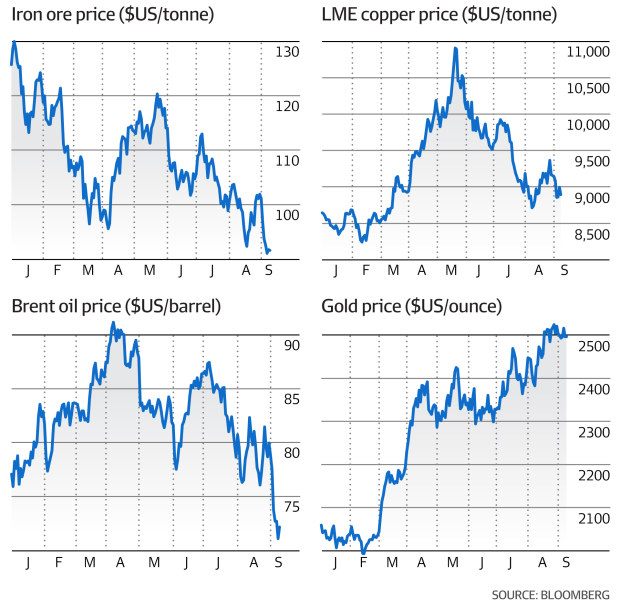Iron ore drops below $US90 as China ‘contagion’ batters commodities
Alex GluyasMarkets reporter
Sep 9, 2024 – 4.12pm
Fears of a slowdown in the world’s largest economies has injected fresh turbulence into commodity markets as traders question whether China can achieve its growth target while US recession risks intensify.
Iron ore dropped below $US90 a tonne on Monday for the first time since November 2022, while Brent oil plunged 10 per cent last week to its lowest close since 2021. Even copper, once hailed as this year’s breakout commodity success, is now in a bear market after diving 20 per cent from its May record.
The violent moves across commodity markets have been fuelled by evidence that Chinese demand for raw materials is dwindling while physical markets remain oversupplied. Investment banks are cutting their growth forecasts, believing Beijing risks undershooting its official target of about 5 per cent.
Those concerns were heightened on Monday by data showing China’s consumer prices rose by a softer-than-expected 0.6 per cent last month as policymakers struggle to stimulate consumer spending. Factory-gate prices remained stuck in deflation, as they’ve been since late 2022, with the producer price index sliding more than projected.
The figures compounded jittery financial markets which were spooked by Friday’s monthly US jobs report which showed that hiring fell short of forecasts in August following downward revisions to the prior two months.
“The recovery in equities [last month] suggested that China’s woes may be isolated to China, and could even be good news for the rest of the world to the extent that commodity prices are falling, causing bond yields and interest rates to drop,” said Barrenjoey’s chief macro strategist Damien Boey.
“But markets are now starting to recognise that if things are bad in China, there will be contagion from that, which is what we’re seeing in commodity markets.”
The collapse in iron ore prices, which sank nearly 10 per cent last week, reflects soft steel consumption in China amid a deteriorating property sector. That caused profitability at steel mills in August to hit the lowest level in decades, exacerbating a build-up of iron ore inventory at ports.
Steel production in China dropped 6 per cent in July compared to a year earlier and Westpac forecasts output to fall more than 9 per cent in August, leaving combined production for the two months at the lowest since 2018.
Rapid unwind
“The incentive to produce steel in China... remains weak given steel mill margins turned more negative last week,” said Commonwealth Bank resources analyst Vivek Dhar. “While margins are still not as negative as they were during most of the second half of August, they are negative enough for iron ore prices to be pressured lower in the near term.”
Iron ore futures in Singapore fell as much as 2.3 per cent to $US89.60 a tonne on Monday before trading back above $US90 a tonne.
The bearish sentiment has spilled over to metals markets, with traders rapidly unwinding bullish bets on copper – a bellwether for the global economy – as soft Chinese demand collides with signs of oversupply.
That saw Goldman Sachs exit its long-standing position in the metal last week well short of its price target of $US15,000 ($22,300) a tonne next year. The broker cut that forecast by a third to an average of $US10,100 a tonne in 2025.
Citi reiterated its cautious stance on base metals in the run-up to the US presidential election in November, warning that uncertainty about the result will subdue global risk appetite and delay stimulus in China.
“We see no imminent catalyst for a sustained turnaround in tepid hard and soft cyclical demand indicators until after the election,” said Citi analyst Tom Mulqueen.
The London Metal Exchange index of six metals is up just 3 per cent this year compared to a 25 per cent gain in mid-May.
While Brent prices rebounded on Monday, the global oil benchmark is still trading around $US72 a barrel amid the slowdowns in the US and China which has coincided with abundant supply.
Gold remains the shining light in commodity markets and continues to hover just shy of its August record high of $US2531.75 an ounce.
The precious metal has been buoyed by growing bets that the US Federal Reserve will start easing policy this month, while robust haven demand due to conflicts in Ukraine and the Middle East have added to bullish sentiment.
Meanwhile, central bank and Chinese consumer demand remains strong.
RBC Capital Markets told clients on Monday it expects records to keep falling, lifting its 2025 average price forecast to $US2835 an ounce.
With Bloomberg
- Forums
- ASX - General
- Its Over
Its Over, page-23619
-
- There are more pages in this discussion • 2 more messages in this thread...
You’re viewing a single post only. To view the entire thread just sign in or Join Now (FREE)





